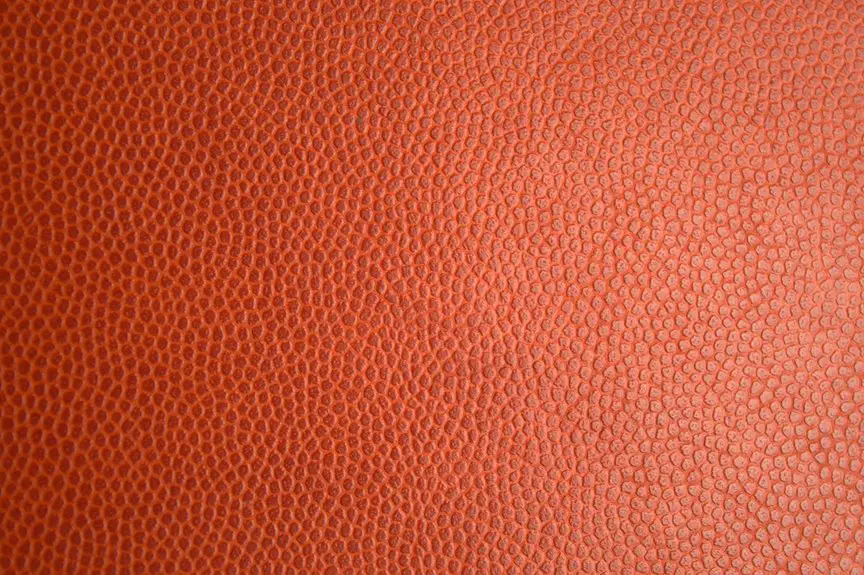To dye your upholstery fabric, first identify the fabric type to choose the right dye—fiber-reactive for cotton, acid for wool, or disperse for synthetics. Clean and dry the fabric thoroughly, then test a small patch to guarantee good results. Apply dye evenly with a sponge or spray, working in sections to avoid patchiness. Allow it to dry completely, and follow care tips to maintain color vibrancy. Stick around to discover expert tricks and troubleshooting tips for a flawless finish.
Table of Contents
Key Takeaways
- Identify upholstery fabric type to choose compatible dye for vibrant, even results and avoid damage.
- Thoroughly clean and dry upholstery, testing a hidden area before dyeing to ensure dye absorption and color compatibility.
- Prepare and apply dye evenly in sections using a sponge or spray, following manufacturer instructions for consistent color.
- Allow proper drying time between coats and heat-set dye if required to lock in color and prevent fading.
- Maintain dyed upholstery by avoiding direct sunlight, using mild cleaners, vacuuming regularly, and applying fixatives to prolong color vibrancy.
Understanding Upholstery Fabric Types and Their Dye Compatibility
Before you start dyeing upholstery fabric, you need to understand how different fabric types react to various dyes.
Natural fibers like cotton, linen, and wool absorb dye more readily, giving you vibrant, long-lasting colors. On the other hand, synthetic fabrics such as polyester and nylon don’t take dye as easily because their fibers repel water-based dyes.
Natural fibers absorb dye well for vibrant colors, while synthetics resist water-based dyes.
You’ll find that blends, combining natural and synthetic fibers, might dye unevenly, requiring careful attention.
Also, keep in mind that upholstery fabrics often have finishes or treatments that can affect dye absorption, so testing a small, hidden area first is essential.
Knowing your fabric type helps you avoid disappointing results and prepares you to choose the best dyeing method to achieve a flawless, refreshed look.
Selecting the Right Dye for Your Upholstery Fabric
You’ll want to match your dye to your upholstery fabric type to guarantee the best results.
Different dyes work better on specific materials, so understanding your options is key.
Also, consider colorfastness and durability to keep your fabric looking fresh over time.
Fabric Type Compatibility
Choosing the right dye for your upholstery fabric depends largely on the material’s fiber content. Natural fibers like cotton and linen absorb dyes differently than synthetics such as polyester or nylon. Knowing your fabric type helps you pick a dye that bonds well and lasts longer.
Here’s a quick guide on fabric compatibility:
| Fabric Type | Dye Compatibility |
|---|---|
| Cotton/Linen | Fiber reactive dyes |
| Wool/Silk | Acid dyes |
| Polyester/Nylon | Disperse dyes |
Before dyeing, check your fabric’s label or test a small hidden area. This prevents unwanted results and guarantees your chosen dye works effectively with your upholstery fabric.
Dye Types Overview
A solid understanding of dye types helps you pick the best option for your upholstery fabric.
Fiber-reactive dyes work great with natural fibers like cotton or linen, bonding chemically for vibrant, long-lasting colors. If your fabric is synthetic, disperse dyes are your go-to—they penetrate polyester or nylon well.
Acid dyes suit protein fibers such as wool or silk, offering rich hues and good penetration. All-purpose dyes claim versatility but often yield uneven results on mixed fibers, so use them cautiously.
Remember, the dye type you choose must match your fabric for effective coloring. Knowing these basics guarantees you avoid wasted effort and achieve the look you want without surprises during the dyeing process.
Select wisely to transform your upholstery beautifully.
Colorfastness and Durability
Three key factors determine how well your upholstery dye holds up over time: colorfastness, durability, and fabric compatibility. You want a dye that resists fading, staining, and wear, ensuring your fabric’s vibrant look lasts.
When selecting a dye, consider these points:
- Colorfastness: Choose dyes labeled as colorfast to prevent bleeding or fading with washing and sunlight exposure.
- Durability: Opt for dyes designed for upholstery that withstand frequent use and abrasion.
- Fabric Compatibility: Match the dye type to your fabric fiber—natural fibers need different dyes than synthetics.
- Application Method: Some dyes penetrate deeper, improving longevity, so follow instructions carefully for best results.
Preparing Your Upholstery for Dyeing
Before you start dyeing, make certain to clean your upholstery thoroughly to remove any dirt or oils that could affect dye absorption.
Next, test a small, hidden area of the fabric to check how it reacts to the dye.
These steps will help guarantee a smooth, even color change.
Cleaning Upholstery Thoroughly
Since dye adheres best to clean fabric, you’ll want to remove all dirt, oils, and stains from your upholstery before starting.
Follow these steps to guarantee your fabric is ready for dyeing:
- Vacuum thoroughly to remove dust and loose debris.
- Spot-clean stains using a fabric-appropriate cleaner.
- Use a mild detergent solution to gently wash the fabric, avoiding oversaturation.
- Allow the upholstery to dry completely, preferably air-drying to prevent mold or mildew.
Taking the time to clean your upholstery thoroughly will help the dye penetrate evenly and stick properly, resulting in a vibrant, long-lasting finish.
Skipping this essential step can cause uneven color and poor adhesion, so don’t rush it!
Testing Fabric Compatibility
Although dyeing upholstery can transform your furniture, you need to test the fabric’s compatibility first to avoid damage or poor results.
Start by identifying the fabric type—natural fibers like cotton and linen absorb dye well, while synthetics like polyester can be tricky.
Next, mix a small amount of dye according to instructions. Choose a hidden spot on your upholstery and apply the dye with a cotton swab or small brush.
Let it dry completely and check for color absorption, fabric texture changes, or bleeding. If the fabric resists dye or shows damage, consider alternative methods or professional help.
Testing guarantees your final result looks vibrant and lasts without harming your upholstery’s integrity. Don’t skip this essential step before dyeing.
Step-by-Step Process for Dyeing Upholstery Fabric
When you decide to dye upholstery fabric, following a clear step-by-step process guarantees even color and lasting results.
Start by thoroughly cleaning the fabric to remove dirt and oils that can block dye absorption.
Next, prepare your dye solution according to the instructions, ensuring it’s well-mixed for uniform color.
Then, evenly apply the dye using a sponge or spray bottle, working in sections to avoid streaks.
Finally, let the fabric dry completely in a well-ventilated area, and heat-set the dye if required to lock in the color.
- Clean fabric thoroughly
- Mix dye solution properly
- Apply dye evenly in sections
- Dry and heat-set for durability
Stick to these steps, and you’ll refresh your upholstery beautifully.
Tips for Achieving Even Color and Avoiding Stains
To achieve even color and avoid stains, you need to prepare both your fabric and workspace carefully. First, clean the fabric thoroughly to remove dirt and oils. Work in a well-ventilated, clean area with a drop cloth to catch spills. Use gloves to protect your hands and prevent transferring oils to the fabric. Stir the dye consistently and apply it evenly, working in small sections. Avoid over-saturating any one spot to prevent blotches.
| Tip | Reason |
|---|---|
| Pre-wash fabric | Removes dirt for uniform dyeing |
| Use gloves | Prevents transfer of oils |
| Stir dye constantly | Guarantees even color distribution |
Following these tips will help you get a smooth, vibrant finish without unwanted stains.
Caring for Dyed Upholstery to Maintain Vibrancy
Once you’ve achieved an even, vibrant dye on your upholstery, keeping that color fresh requires consistent care.
Maintaining a vibrant upholstery color takes ongoing care and attention to keep it looking fresh.
To maintain its brilliance, follow these steps:
- Avoid Direct Sunlight: Prolonged exposure can fade colors, so place your furniture away from windows or use curtains.
- Clean Gently: Use mild detergents and avoid harsh chemicals that can strip dye from the fabric.
- Vacuum Regularly: Removing dust prevents buildup that dulls colors and wears fabric fibers.
- Spot Clean Quickly: Address spills immediately with a damp cloth to prevent stains from setting and affecting the dye.
Troubleshooting Common Issues When Dyeing Upholstery
Although dyeing upholstery can transform your furniture, you might encounter issues like uneven color, fading, or fabric damage.
If your dye looks patchy, make sure you apply it evenly and use a fabric brush or sponge for consistent coverage.
Fading often happens when the fabric isn’t properly sealed; always use a fixative or sealant to lock in color.
If the fabric feels stiff or damaged, check that you’re using the right dye type and avoid over-saturating the material.
Test a small hidden area before full application to spot problems early.
Remember, proper preparation and following instructions carefully can prevent most issues.
If problems persist, consider consulting a professional for advice to save your upholstery’s new look.
Frequently Asked Questions
Can I Dye Upholstery Fabric Without Removing It From the Furniture?
You can dye upholstery fabric without removing it, but it’s tricky. You’ll need to protect surrounding areas and apply dye carefully to avoid uneven color or damage. Testing a small spot first really helps too.
How Long Does Upholstery Dye Typically Take to Dry Completely?
Upholstery dye usually takes about 24 to 48 hours to dry completely. You’ll want to avoid using or sitting on the fabric during this time to guarantee the color sets well and lasts longer.
Is It Safe to Dye Upholstery Fabric Around Pets and Children?
Oh, sure, let your pets and kids sniff paint fumes like it’s a new gourmet scent! But seriously, you shouldn’t. Keep them away until the dye’s dry to avoid sneezing, licking, or accidental art projects.
Can I Mix Different Dye Brands for Custom Colors?
You can mix different dye brands to create custom colors, but be cautious. Test a small fabric piece first to guarantee compatibility and desired results. Different formulas may react unpredictably or affect colorfastness.
Will Dyeing Upholstery Affect Fabric Texture or Softness?
You might notice dyeing can darken colors, change texture, or reduce softness. You shouldn’t expect fabric to feel exactly the same after dyeing, but you can minimize changes by choosing gentle dyes and following care instructions carefully.
- What Is a Nonwoven Textile? a Broad Definition - July 9, 2025
- What Is a Nonwoven Textile? a Broad Definition - July 9, 2025
- What Is a Nonwoven Textile? a Broad Definition - July 9, 2025




